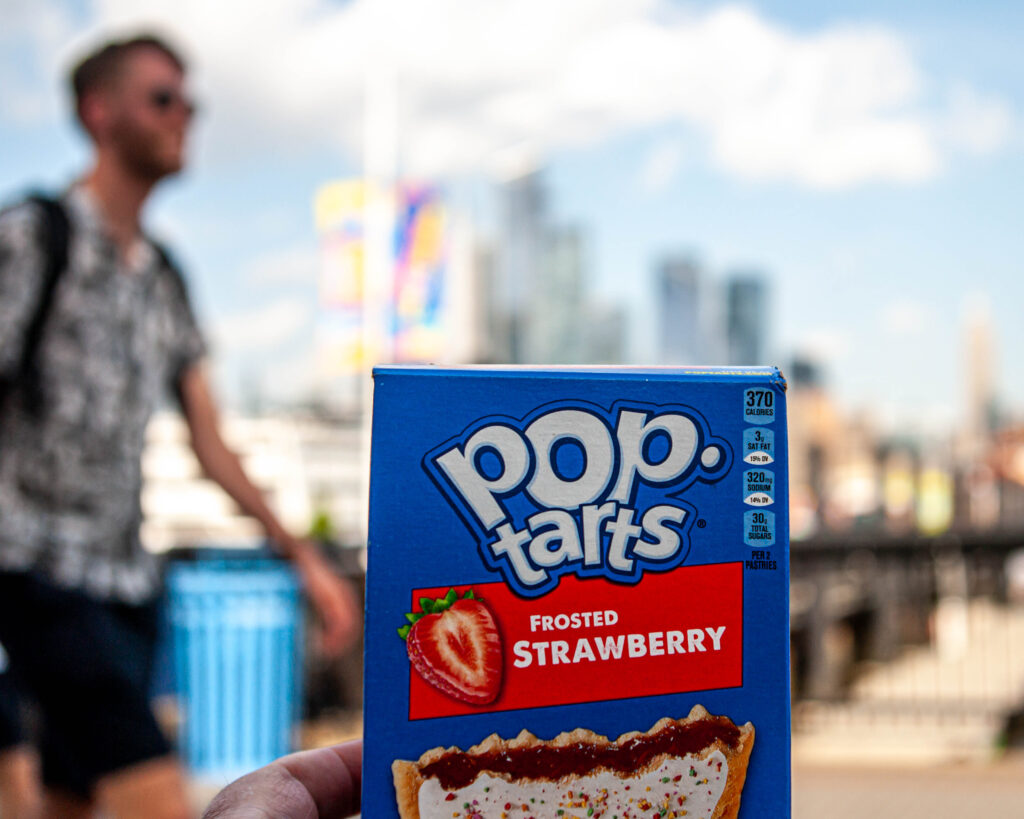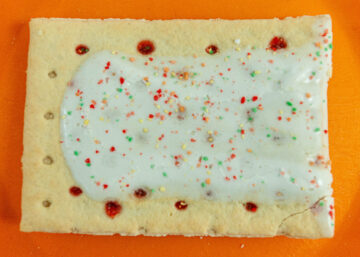
From beginning to end, Unfrosted is constructed with the intricacy of Seinfeld’s stand-up bits. Taken as a sequence of five-minute segments it’s wonderful, and there are resonances among and mid- and long-range connections among those segments. But you can’t carry an hour and 20-minute film on watch-making intricacy alone. There’s got to be a compelling story, a plot. Oh, we’ve got lots of plotting: Kellogg’s vs. Post, Big Milk vs. Big Cereal, Cuban sugar vs. Puerto-Rican sugar, Russia vs. America, mascots vs. Kellogg’s, and all the while NASA’s shooting for the moon. What holds that together? Pop-Tarts
And that’s not enough. As I noted in my original review, “You can’t take a Godzilla toy, hook it up to an air-pump, and expect to inflate it into a world-destroying comedic monster.” Unfrosted in meticulously crafted, but unfocused and rambling.
It’s not enough. Pop-Tarts themselves exist at the right scale for a meticulously-crafted stand-up bit, which is where the movie started, as a stand-up bit. But in a feature-length film Pop-Tarts are reduced to being a MacGuffin. “MacGuffin” is a term of art that means – I’m quoting the dictionary on my computer – “an object or device in a movie or a book that serves merely as a trigger for the plot.” The statue in The Maltese Falcon is a classic example. It turns out to be junk, but it motivates the action.
Let’s take a closer look at Unfrosted. I’m going to start by looking at Seinfeld’s bit about Pop-Tarts, then look at the movie itself, and conclude with some speculative observations about Seinfeld’s aesthetic confusion.
The anatomy of a 3-minute bit
Let’s start with the Pop-Tarts bit, which runs 64 lines in Seinfeld’s book, Is This Anything? We can break it down into five parts. The first part is so short I’ll quote it in full:
Different foods hit you different at different ages.
When I was a kid,
and they invented the Pop-Tart,
the back of my head blew right off.
That last line is strong. It’s hard to build-up from that.
Seinfeld starts the second section with a reset: “We couldn’t comprehend it.” This section is much longer (94 words vs. 26), likening the Pop-Tart to “an alien spaceship.” In contrast “we were just chimps in the dirt playing with sticks.” The Pop-Tarts are sealed in silver packages: “Some metallic alloy from NASA, in case of a Russian satellite gamma ray attack.” There you have it, the seeds of the conceit driving the film: Unfrosted treats the competition between Post and Kellogg’s as one on the world-historical scale of America and Russia racing for the moon.
We move to the third section, the middle, which is even longer – 157 words – than the second. It opens with home and mother: “I’d see my mother cooking in the kitchen.” Breakfast was tough, TOAST (capitalized for some reason), frozen orange juice, and Shredded Wheat. “It was like wrapping your lips around a wood chipper.” Cream of Wheat had its problems as well, “It was like wrapping your lips around a wood chipper.”
And so we move to the fourth section. At 126 words it is longer than the second, but not as long as the middle. We move from home to Battle Creek, Michigan, “the corporate headquarters of Kellogg’s.” We return to the technology theme where Battle Creek is pitched as “some kind of cereal Silicon Valley. Filled with Breakfast Super Scientists working on frosted, fruit-filled, heatable rectangles.” Interestingly, Seinfeld gives us a note of skepticism, telling us that those rectangles have “the same nutrition as the box it comes in.” He ends by comparing those paired Pop-Tarts with “the two tablets of the 10 Commandments.” That certainly calls for a reset.
The fifth and last section is so short, only 37 words, that I’ll quote it in full:
“The Pop-Tart is here.
Two in the packet.
Two slots in the toaster.
Let’s see you screw this up.
Why two?
One’s not enough.
Three’s too many.
And they can’t go stale.
Because they were never fresh!”
Notice that last line, these delicious high-tech food wonders “were never fresh.” That does not sound like a ringing endorsement. Are they really the sort of thing that blows the back of one’s head off? Well, I figure it was a 10-year-old kid who had the back of his head blown off, but it’s an adult telling us they were never fresh. The bit dwells in childhood until the very end, where it yanks us into adulthood in a way that’s so clever we can only laugh.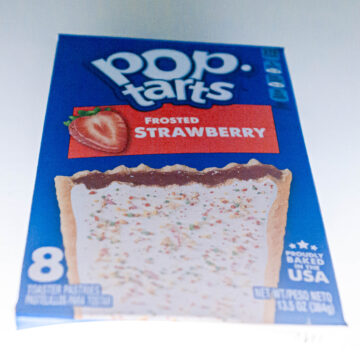
What happened to breakfast?
When Seinfeld transformed that bit into a movie, he dropped the middle section, breakfast in the morning with mother. Mother’s gone and breakfast has become transformed. It frames the entire story and then appears within the story in different ways.
Unfrosted opens with a frame tale. A kid is running away from home and tops at a diner for breakfast. What does he order? “Two Pop-Tarts, please. Leave the box.” [Did diners actually serve Pop-Tarts back then?] As it so happens, the kid sat next to none other than Bob Cabana (Jerry Seinfeld), the executive who brought Pop-Tarts into the world. He starts telling the story: “Well, in the early ‘60s, the American morning was defined by milk and cereal.”
While movie opens with breakfast, there’s no mom and the kid’s running away from home. And since this IS a frame tale – you know that’s what it is, because you’ve seen lots of movies and you know that you’re viewing a frame-tale – you know that you’ll find out how things work out. But first we’ve got to listen to this mild-mannered middle-aged guy tell us the TRUE story about Pop-Tarts.
We cut to Bob Cabana walking out the front door of his home, giving his wife a kiss, and heading off to work. We’ll see this scene several times later in the film. The last time Bob will be abducted by the milk mob and whisked off to an interrogation by a short mob boss dressed in a white suit like Tatu from Fantasy Island – or perhaps not, as that show’s a decade and half after the introduction of Pop-Tarts. But I digress.
Back to breakfast. The next day Cabana decides to drive by Post headquarters on his way to work. He’s driving a nondescript yellow station wagon. It looks like a Chevy “unsafe at any speed” Corvair. They made a Corvair station wagon? Wikipedia says they did. I digress. Cabana stops the car, squints, and sees two kids dumpster diving. A little of this, a little of that, and Bob’s looking over the dumpster’s edge down into the bin:
Cabana: “Are you kids okay?”
Butchie: “Oh, sure. We live in nice homes and already had a complete breakfast.” [Said no kid, EVER.]
Cathy: “But we come here for this.”
Cabana: “It’s Garbage.”
Cathy: “Is it? Or is it some hot fruit lightning the man doesn’t want you to have?”
“The man, the man”? What ten-year-old girl talked like that in 1964?
Bob has a taste. His eyes pop wide open. The sky thunders and lightnings behind him. He rushes to Kellogg’s office: “They got a fruit-filled pastry dingus.” For the purposes of this movie, “dingus” is a term of art and will return several times.
Once again we have kids and something like breakfast, but not at home, and no mom. These kids are out adventuring.
Later on there’s a scene at Kellogg’s headquarters. Cabana’s brought top food scientist, Donna Stankowski (Melissa McCarthy) from NASA back to Kellogg’s. They’re talking about the upcoming research when they are joined by Edsel Kellogg III (Jim Gaffigan), head of the company. After some chit-chat they decide to “bowl up” and head to the mechanical cereal dispenser in the company cafeteria. We get close-ups of bowls of cereal, spoons dripping of milk and cereal, open mouths, lips, and a bit of conversation:
Cabana: “The magic of cereal is you’re eating and drinking at the same time with one hand.”
Stankowski: “What we need to be able to do is recreate this euphoric gratification.”
Cabana: “But in a completely new way.”
Kellogg: “Well, all of Kellogg’s manpower is at your disposal.”
This is not breakfast. No kids, no mom, no home. This is adults having a meeting at work.
Now things get serious. The research has been successful. In a scene staged as a parody of a NASA launch, the “taste pilot” [hint, hint] declares “We’ve got a treat!” and then dies in a freak accident – perhaps a reference to the launch-pad explosion of Apollo 1 in 1967 that killed three astronauts. When the smoke clears the scene switches to his funeral, with “full cereal honors.”
The graveside ceremony is a parody of a military burial, including Snap, Crackle, and Pop as ceremonial bag-pipers. As the coffin is lowered into the grave, Toucan Sam, one of the cereal mascots (for Froot Loops), begins singing “Ave Maria.” Now at least we’ve got mother in attendance, if only indirectly. Two cereal mascots empty large boxes of Corn Flakes into the grave, followed by two more mascots pouring milk into it. The coffin floats, some grief-struck woman slices a banana, and then Snap, Crackle, and Pop present the grieving widow with “the prize inside,” which they’ve folded nicely into a triangle. The widow exits in disgust and anger.
Part of me is, frankly, a bit startled that I’m saying that we should read this as a parody of breakfast. But what other choice have we? Moreover, in a group interview involving members of the cast, Seinfeld says (at about 8:05 in the clip below): “There was no reason to kill that guy. I just wanted to do the funeral”
He goes on to observe: “Being a cereal obsessive, anything that’s a hole, I wanna’ put milk and cereal in it.” Sarah Cooper, who was being interviewed at the same time, did not let that one by without making a comment: “Anything that’s a hole?” (with a gently rising intonation). Laughter ensued.
There’s one last breakfast-scene substitute we have to examine. Kellogg’s is looking for a name for their fruit-filled pastry dingus. They bring in some talent from New York, Don Draper and Roger Sterling from Mad Men. We’re seated around a conference table and Draper is standing at the head of the table next to the easel containing his slides. He goes into his pitch:
Kellogg’s. When you hear it it’s more than a name. It’s the warm embrace of home, of family. And where does that family begin? It begins with two beating hearts. Like two pastries, alone, in the dark, sharing a single foil wrapper.
That sounds promising. That Draper magic we’ve seen so many times. Smiles. You’ve got our attention. He continues:
Imagine a husband coming home from work. His wife greets him at the door, wearing a satin negligée, leads him into the bedroom, with one flick of a red polished nail, she ignites the coiled heat from a nearby toaster, which is also eager to receive his now warm pastries.
Gentlemen, I give you, the Jelle Jolie by Martine Margeaux.
WTF!!!
Edsel Kellogg: “Uh, You know we’re a kid’s cereal company, right?”
Draper: “If that’s all you wanna be.”
Sterling: “I’ve been in your town for six hours. You know what I see? Dead trees, and sad lonely women.”
Needless to say, Draper and Sterling don’t get the account.
(“Jelle Jolie” seemed familiar, so I did a search and confirmed what my Spidey sense was telling me, Belle Jolie was the account at Sterling Cooper where Peggy Olson got her chance at writing ad copy.)
Where are we? Breakfast. While the mom-cereal-and-kid scene from the bit doesn’t appear in the movie, various modified versions of it are here in parody form. Food, mother, death (the burial), and sex (Jelle Jolie) are all central to life. Seinfeld’s got them all here, closely linked to Pop-Tarts.
If I were in a Freudian mood, I’d say that was something to look into. But I’m not, at least not yet. Let’s move on.
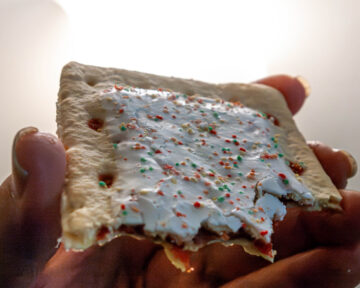
Lost in the funhouse of the hyperreal
Now I want to switch gears and quote from Richard Roeper’s (scathing) review in the Chicago-Sun-Times. He notes that Hugh Grant is cast as Thurl Ravenscroft, the real actor who voiced Tony the Tiger, with
Kyle Mooney, Mikey Day and Drew Tarver as Snap, Crackle and Pop, respectively.
This is one of the many inexplicable elements in “Unfrosted” — Grant plays Ravenscroft, who plays Tony the Tiger, but Snap, Crackle and Pop are depicted not as actors, but as individuals named Snap, Crackle and Pop. They seem to have no normal human alter egos; they’re never out of character. The same goes for Chef Boyardee (Bobby Moynihan) and Isaiah Lamb (Andy Daly), aka the Quaker Oats guy. These characters are depicted not as actors playing roles, but as the living embodiments of their respective brands.
To make matters more confusing, they interact with “real” people such as […] Jack LaLanne (James Marsden) and Harold von Braunhunt (Thomas Lennon), the huckster known for gimmicks such as X-ray specs and “Amazing Sea Monkeys.” Why are those latter characters from other fields in a Pop-Tarts movie? Mainly so that “Unfrosted” can waste an inordinate amount of time on scenes that parody “The Right Stuff” […] We also get inside gags referencing “The Godfather” and “Apocalypse Now.”
There’s a lot of business going on in this film, a lot, and different registers of reality, if you will, are mixed and matched according to no obvious scheme. Clever? Yes. But all the mental energy you devote to decoding this cleverness diffuses the narrative momentum.
It’s standard for biopics to mix real characters with fictional ones. Ravenscroft, Walter Cronkite, Marjorie Post, John F. Kennedy, and and a host of others are real people. But Edsel Kellogg, Bob Cabana, Donna Stankowski, Harry Friendly, and El Sucre are not. Peggy Northcutt (Sarah Cooper) is a real person, but she was a NASA engineer, not an assistant to a cereal executive (Cabana). And then we have mixing of people with mascots, a bit like the interaction between people and Toons in Who Framed Roger Rabbit. To this I’d add that including Don Draper and Roger Sterling from Mad Men is a bit like having Batman and Robin play a scene somewhere in the Marvel Comic Universe.
What gives? Where’s reality? Or isn’t that a meaningful concept in this movie? Oh, sure, I know, none of its real, not really. This is fiction, sorta’. But Pop-Tarts are real and they were invented in the early 1960s and there was competition between Post and Kellogg’s about marketing fruit-filled, heatable rectangles. This is about world-building. This fictive world makes no distinctions between ontological registers.
Seinfeld appears to have been seduced by the hyperreal (Wikipedia):
Hyperreality is a concept in post-structuralism that refers to the process of the evolution of notions of reality, leading to a cultural state of confusion between signs and symbols invented to stand in for reality, and direct perceptions of consensus reality. Hyperreality is seen as a condition in which, because of the compression of perceptions of reality in culture and media, what is generally regarded as real and what is understood as fiction are seamlessly blended together in experiences so that there is no longer any clear distinction between where one ends and the other begins.
And then we have the language games, which, in a way, is what stand-up is all about, at least Seinfeld’s kind of stand-up. There’s endless business about names for these flavored cardboard squares. Post has come up with “Dextrose Dillies”, “Wonder Gels,” and “Fresh Flatties.” In a session with Butchie and Cathy, the two kids Cabana originally encountered diving in Post’s dumpsters, the brainiacs at Kellogg’s come up with some real winners: “Fruit-Magoos,” “Heat ‘Em Up and Eat ‘Em Ups,” “Oblong Nibblers” (sounds like fish bait). The kids aren’t buying it: Butchie: “Look, the name is the game, people. If we like the name, we’ll eat it.” What about taste?
After a bit of intense grilling from Stankowski and Kellogg, Cathy stands up and offers up a line from Seinfeld’s original bit:
Cathy: “You wanna’ know the truth? I took one bite, and it blew the back of my head right off. It was the most delicious piece of pastry I’ve ever had, and I’ve had them all.”
Cabana: “Well, you never had ours. Give it to her.”
She takes a bite: “This tastes like their thing.” Cabana observes: “Everybody makes the same thing. Coke and Pepsi. Ford and Chevy. The important thing is the name.”
We’re now deep in the philosophical currents that swept through universities in the 1970s and 1980s, the problematic relationship between words and things. Moreover this issue is Seinfeld’s bread and butter as a comedian (think of his bit about donut holes). But you can’t sustain an hour-and-half-long movie on word play. That takes us back where we began, with an elaborate web of plotting culminating in a nuclear stand-off and an assault on Kellogg’s that reduces the original bit to the status of a MacGuffin. That would be acceptable if the movie shed some light on that whole rickety socio-cultural apparatus. But it doesn’t. It keeps insisting that it really is about Pop-Tarts and all the rest of it is just, well, it’s just there.
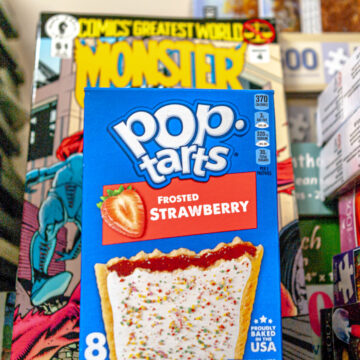
From Duck Soup to Galaxy Quest
Let’s consider another negative review. Here’s Matt Zoller Seitz at Roger Ebert. This passage starts with the same complaint about mixed reality that Roeper made, but then goes somewhere else with it:
There’s no discernible aesthetic, only an immaculate but anonymous-seeming version of craft. In a sense, you could say “Unfrosted” is a very faithful adaptation, because the source is a Seinfeld standup routine on Pop-Tarts, and Seinfeld never cares about anything he talks about in his comedy, which is aggressively, at times petulantly trivial. His immense wealth so insulates him from the real world that he can afford to be the most blasé person alive, rising to passion only when griping to interviewers that comedy has become too woke.
Yes, I know that Seinfeld is rich, but “the most blasé person alive”? Nah. Yet Seitz is pointing at something that’s very real about this film. I take that nasty crack as a misplaced attempt to come up with some way of accounting for the overall flatness and emptiness of Unfrosted.
I find this remark more useful:
Seinfeld keeps going for Jerry Lewis or Looney Tunes-style surreal-absurd visual humor, like showing a spy camera barely hidden in the strands of a wet mop that’s actively being used to clean a floor, or having one of the early Pop Tarts prototypes escape from a tank and scuttle around like an edible Pikachu. But he doesn’t have the eye, the timing, or the anarchic spirit to pull it off….
Yes to “surreal-absurd visual humor” and “anarchic spirit.” That’s what’s missing.
Let’s think about Duck Soup, a marvelous movie in which Groucho Marx plays Rufus T. Firefly, a conman and a grifter who has been pursuing Mrs. Gloria Teasdale. She’s been propping up the small nation of Freedonia with her fortune and has had Firefly installed as the leader. Ambassador Trentino of Sylvania has also been pursuing Mrs. Teasdale. Teasdale, Trentino and others are straight-arrows who are being manipulated by Firefly. He’s not particularly malevolent, just greedy and self-interested. Groucho’s brothers, Chico (as Chicolini) and Harpo (as Pinky), play spies for Sylvania, though their allegiance turns out to be rather flexible. The three of them open things up and provide room for the anarchic spirit and surreal-absurd visual humor that Unfrosted lacks.
But I don’t see how, say, Bob Cabana or Edsel Kellogg could be reconstructed as a Rufus T. Firefly character without forcing a radical change in the movie. With the possible exception of the two kids, Butchie and Cathy, all the characters are pretty straight. Yes, they may wear silly costumes (the mascots) and they may be absurd (the “taste pilots”) but they are nonetheless straight. They are functioning parts of the existing social order doing there best to function within it, not anarchic forces from the outside like Firefly, Chinolini, and Pinky.
I think Galaxy Quest might provide us with a more fruitful model. As you may recall, it is about a troupe of actors who played the crew of a TV-show like Star Trek. The show’s gone off the air and the cast now travel around to fan conventions and promotional appearances. It so happens that some aliens far far away, Thermians, have seen broadcasts of the TV-show and, mistaking them for historical documents, have modeled their society on the show. The Thermians show up one day looking for help deal. This, that, and the other – it’s complicated – and it falls to a group of fans to provide the knowledge necessary to secure a happy ending for both the Thermians and our actors.
That is to say, it’s the kids who save the day. These kids are teenagers rather than the preadolescents in Unfrosted, but they’re kids. They’re not adults. They look at the world differently.
And that’s what the kids in Unfrosted do. Their entrance into the film is rather a bit spectacular. As I said before, Butchie and Cathy were dumpster diving at Post’s headquarters. But it’s more than that. We see them go into one dumpster, which is then picked up by a garbage truck and emptied into the hopper. How can the kids survive THAT? Just fine, it turns out. They tumble out and immediately run into a different dumpster. That’s where Cabana talks to them that “hot fruit lightening” they’ve been scraping out of the dumpsters.
That’s quite an entrance, as though the trip through the belly of the garbage truck were an initiation ritual marking these kids as somehow special. The fact is, this whole silly Rube Goldberg plot revolves around their reactions to those pastries. And they provide the information Kellogg’s needs to create Pop-Tarts. The much-ballyhooed team of taste pilots has failed to deliver a meaningful product. Cabana is taking their useless inventions out to the dumpster. Guess who’s there?
Butchie: “Oh, hi, Mr. Cabana.”
Cabana: “Butchie, Cathy, what are you guys doing here? Why– Why aren’t you in the Post dumpsters?”
Butchie: “They started spraying coyote urine to keep us out.”
Cabana: “Oh, that’s a same. Well, you won’t find anything good in our trash.”
Cathy: “Oh, yeah? Look at this.”
Cabana: “What is that?”
Butchie: “It’s stale Rice Krispies and melted marshmallows.”
Cathy: “It’s a treat.”
Butchie: “You know, Bob, we’ve been through this before. When you’re dealing with garbage, you have to let go of conventional expectation.”
Cathy: “Just combine whatever you have.”
Cabana: “You kids sure get philosophical in these dumpsters.”
And that does it. Cabana comes back to the lab and tells Stankowski: “you let go of all your expectations and just combine whatever you have.” They then sketch out a plan for their pastry. “Stan, my friend, I believe we have split the atom of breakfast.” This realization is followed by a musical number, with Kellogg’s employees dancing to Chubby Checker, “The Twist.” The kids have put the adults on the right path, and we’re less than halfway through the film. Later, as we have already seen, film they’ll underline the importance of getting the right name.
What I am suggesting, then, is that the kids are at the center of the movie, not simply as the recipients of this marvelous pastry that can’t be stale because it was never fresh, but as agents in the creation of that pastry. The agency of kids is clear in Galaxy Quest, but it is muddled in Unfrosted. Whereas the kids are in on the action at the end of Galaxy Quest, Butchie and Cathy play no role in Unfrosted in the last ten minutes when Kellogg’s finally triumphs. They don’t join in the triumph.
The elephant in the room
By which I mean sex. Seinfeld doesn’t work “blue,” something he’s explained in various interviews over the years. Though there’s a sexual innuendo here and there, there’s nothing overt. The original Pop-Tarts bit is crispy clean.
Not so with Unfrosted. We’ve already looked at the scene where Don Draper suggests that Kellogg’s markets Pop-Tarts as some kind of sexual aid, perhaps a lubricant (Jelle Jolie). Just what IS that scene doing in this movie? Is it just another opportunity for a gag or three that not only do not advance the narrative, but may even distract us from it? Why work so hard to suggest that a kid’s breakfast pastry is some kind of come-on from Mom to Dad?
Beyond this there’s a running gag about sexual tension between the head of Kellogg’s, Edsel Kellogg, and the head of Post, Marjorie Post (who, by the way, was a real person, unlike Edsel Kellogg, who is a fiction). This tension almost breaks out in a kiss when, in response to the Cuban Missile Crisis, Edsel visits Marjorie to make peace. They’re dancing the twist in her office (“so feral”) when Edsel leans in for the kiss…and they’re interrupted – I kid you not – by an alien life form that’s escaped from Kellogg’s labs, a living ravioli creature. Is Seinfeld asking us to believe that American and Russia were driven to the brink of a nuclear war by repressed sexual desire driving Kellogg’s and Post to compete over breakfast pastry? That’s Stanley Kubrick country, Dr. Strangelove.
I would not be beyond the bounds of current interpretive practice to suggest that Unfrosted is somehow about childhood creativity as an antidote to adult rigidity driven by sexual repression. Do I actually believe that? I do, I don’t, I don’t know. What I do know is that Unfrosted is confused and at odds with itself. Well-crafted? Yes. Taken five minutes at a time it can be very funny. But taken as a whole, Seinfeld has some work to do, some aesthetic work. To borrow a phrase from Seinfeld, he’s not the master of this domain. Not yet.
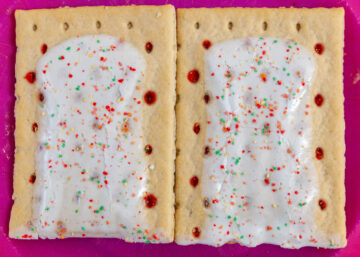
Homework assignment
Silicon Valley is all abuzz these days with the ideas of Rene Girard. Explain the action in Unfrosted in terms of his theory of mimetic desire. Hint: What company was imitating the behavior of what other company and who started first? Is Thurl Ravenscroft a scapegoat in the Girardian sense?
Seinfeld on having kids
Here Seinfeld talks about having kids and how it changed his outlook on the world. Think of this as deep background for this piece.
Other Seinfeld pieces
Here’s a series of posts about Unfrosted at my home blog, New Savanna.
I have a number of other Seinfeld articles at 3QD:
- Analyze This! AI meets Jerry Seinfeld
- Seinfeld On His Craft, Or: Comedy As A Path To Metaphysical Grace
- Jerry Seinfeld and Barack Obama Have a Meeting of the Minds
